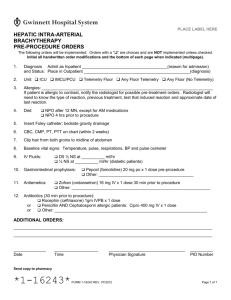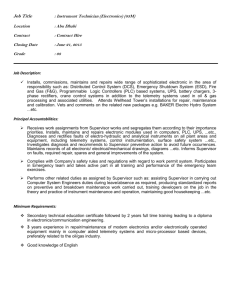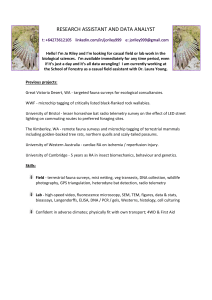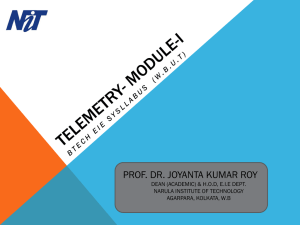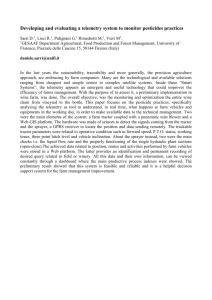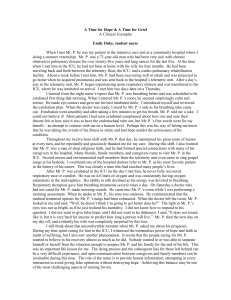DOC - School of Electrical and Computer Engineering at Georgia Tech
advertisement
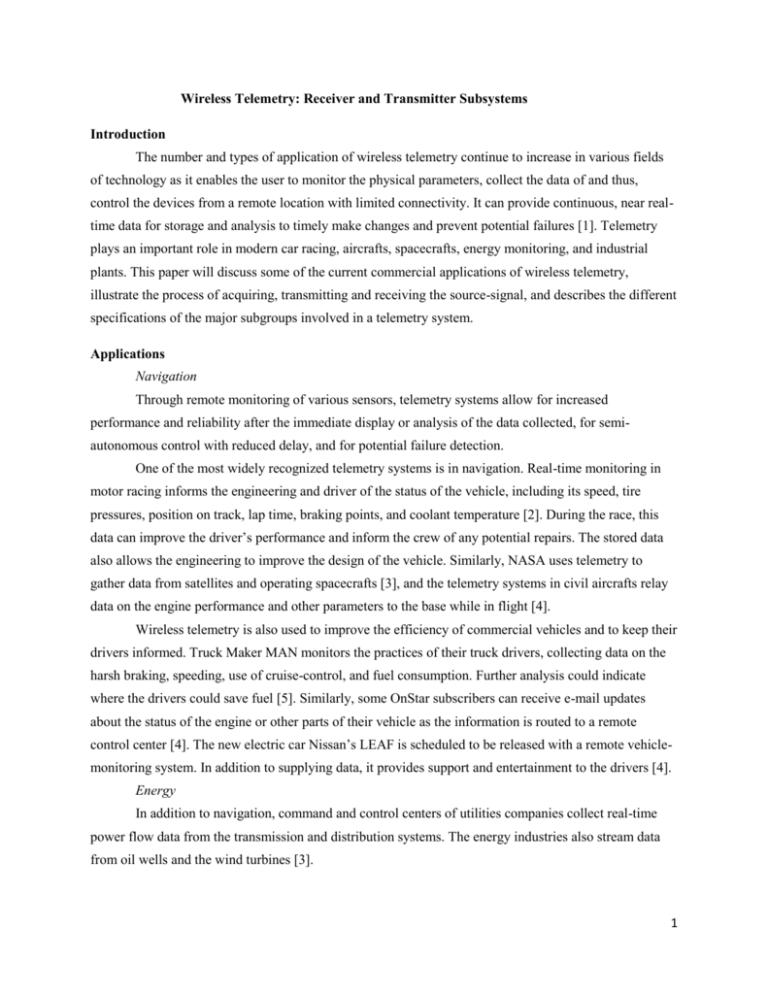
Wireless Telemetry: Receiver and Transmitter Subsystems Introduction The number and types of application of wireless telemetry continue to increase in various fields of technology as it enables the user to monitor the physical parameters, collect the data of and thus, control the devices from a remote location with limited connectivity. It can provide continuous, near realtime data for storage and analysis to timely make changes and prevent potential failures [1]. Telemetry plays an important role in modern car racing, aircrafts, spacecrafts, energy monitoring, and industrial plants. This paper will discuss some of the current commercial applications of wireless telemetry, illustrate the process of acquiring, transmitting and receiving the source-signal, and describes the different specifications of the major subgroups involved in a telemetry system. Applications Navigation Through remote monitoring of various sensors, telemetry systems allow for increased performance and reliability after the immediate display or analysis of the data collected, for semiautonomous control with reduced delay, and for potential failure detection. One of the most widely recognized telemetry systems is in navigation. Real-time monitoring in motor racing informs the engineering and driver of the status of the vehicle, including its speed, tire pressures, position on track, lap time, braking points, and coolant temperature [2]. During the race, this data can improve the driver’s performance and inform the crew of any potential repairs. The stored data also allows the engineering to improve the design of the vehicle. Similarly, NASA uses telemetry to gather data from satellites and operating spacecrafts [3], and the telemetry systems in civil aircrafts relay data on the engine performance and other parameters to the base while in flight [4]. Wireless telemetry is also used to improve the efficiency of commercial vehicles and to keep their drivers informed. Truck Maker MAN monitors the practices of their truck drivers, collecting data on the harsh braking, speeding, use of cruise-control, and fuel consumption. Further analysis could indicate where the drivers could save fuel [5]. Similarly, some OnStar subscribers can receive e-mail updates about the status of the engine or other parts of their vehicle as the information is routed to a remote control center [4]. The new electric car Nissan’s LEAF is scheduled to be released with a remote vehiclemonitoring system. In addition to supplying data, it provides support and entertainment to the drivers [4]. Energy In addition to navigation, command and control centers of utilities companies collect real-time power flow data from the transmission and distribution systems. The energy industries also stream data from oil wells and the wind turbines [3]. 1 Underlying Technology The telemetry system acquires signals from sources, modules and multiplexes the acquired signals, and transmits the data through a medium to a receiver for storage and analysis. The various processes make the signals compatible with the succeeding circuits and multiplex them to transmit them as a series of pulses over a single transmission channel [3]. Different types of sensors exist to monitor a wide range of physical parameters. Various hardware components and algorithm are also available to perform the modulations, multiplexing and commutation of the signal. The signal conditioning can involve amplification, phase shift, frequency change, buffering, filtering, and rectification and nonlinear amplification [6]. The purpose of the conditioning is to ensure the correct frequency response, impedance, ground reference, common mode rejection, and dynamic range [7]. The two forms of signal multiplexing are frequency division multiplexing (FDM) and time division multiplexing (TDM). Various forms of FDM and TDM, such as Pulse Code Modulation (PCM) and Pulse Duration Modulation (PDM), exist to modulate the signal according to the required sampling rate [8]. The bandwidth, accuracy, the number of signals and various other factors determine the type of transmitting system used [6]. Various types of wireless communication exist, such as VHF/UHF radio telemetry, spread spectrum, cellular and satellite telemetry [7]. Building Blocks for Implementation Implemented through hardware and software, the telemetry system consists of two functional major subsystems: transmitter and receiver. Both components are specified by measurement resolution, operating frequency, data rate, interface, and output power and other performance characteristics [7]. Depending on the application, the transmitters and receivers use several different connectors and configurations, such as hole technology, surface mount technology, or stand alone devices [7]. In the transmitting subsystem, transducers (sensors) convert the physical parameters to an electrical signal. Next, the signal processing circuit modifies the transducer output for compatibility with the subsequent circuits and for quality control in the transmission and reception of the signal [8]. It then multiplexing the signals, so that the transmitter converts the signal into a modulated radio frequency signal which the antenna radiates [6]. The supply current and potential interferences with other systems limit the output power of the signal [6]. In the receiving subsystem, the receiving-antenna converts the electromagnetic signal back to an electrical signal of lower frequency [6]. The receiving unit is characterized by noise contribution, frequency, polarization, beamwidth and sidelobe levels and tracking performance [6]. Next, the receiving signal is further modified by a series of demodulators, downconverters and diversity combiner before being routed to the storing and analyzing unit of the telemetry system [6]. Hardware components exist that perform one or several of the functions at once: signal acquisition, signal conditioning, multiplexing, transmitting, pre-amplification, and data processing [6]. 2 References [1] Allen Gale. Class Lecture, Topic: “An Introduction to Telemetry.” Department of Electrical and Computer Engineering & Technology, Minnesota State University, Mankato, MN. [2] I. Wood, “Real-Time Racing Telemetry,” ianwood.com, Mar. 21, 2009. [Online]. Available: http://www.ianwood.com/news/story.asp?sid=36. [Available Sept. 7, 2010]. [3] National Instruments, “Developing a PCM Telemetry Solution with LabVIEW FPGA,” National Instruments, 2010. [Online]. Available: http://zone.ni.com/devzone/cda/tut/p/id/3253 [Accessed: Sep. 5, 2007]. [4] (2009, Nov.) Science and Technology: Calling all cars; Vehicle telemetry. The Economist [Online]. 393(8658), p. 81. Available: http://proquest.umi.com/pqdweb?did=1906255561&Fmt= 3&clientId=30287&RQT=309&VName=PQD [5] “Telemetry monitors truck driver performance in bid to cut fuel use,” Professional Eng., vol. 22, no. 8, p. 46, April 29, 2009. Available: ProQuest, http://www.umi.com/proquest/. [Accessed September 5, 2007]. [6] Telemetry Applicat. Handbook, 2rd ed., Telemetry Group (TG) of the Range Commanders Council (RCC), White Sands, NM, 2006. [7] GLOBALSPEC: The Engineering Search Engine, “Telemetry Receivers and Telemetry Transmitters,” GLOBALSPEC: The Engineering Search Engine. [Online]. Available: http://www.globalspec.com/LearnMore/Communications_Networking/RF_Microwave_Wireless_ Components/Telemetry_Transmitters_Receivers [Accessed: Sept. 5, 2010]. [8] L-3 Communications, “Telemetry Tutorial,” L-3 Communications. [Online] Available: http://www.l-3com.com/tw/telemetry_tutorial/preface.html [Accessed: Sept. 7, 2010]. 3
